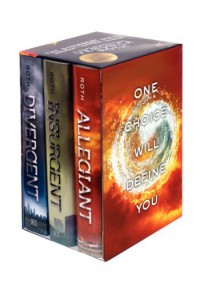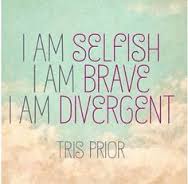

This is probably the only time that I will say that the films were better than the books. Don’t get me wrong, I loved the series. The characters were painfully real and made their strange, dystopian world more believable. I’m definitely the type of reader that finds character development to be my make-or-break aspect of a book. With that said, I would recommend this series to anyone and everyone. Even people that don’t like YA Dystopian novels.
The main character, Tris is not a typical teenage girl. She’s quiet, temperamental and has a hero-complex. And to my surprise (no doubt to the surprise of all YA fans), the heroine is NOT beautiful. OK, so she’s not a stinker either, but she’s not one of those female leads that has glowing skin and flowing locks that make all the boys weak in the knees. She draws attention by her actions and bravery, an important trait for any lead to have. Her love interest, Four, also possesses enough strength and mystery to keep the reader interested. Together, these two characters make this book series great.
Now to the plot…
I’ll try and explain without any spoilers. Essentially, Tris and Four live in Chicago several generations after the fall out of a devastating World War. Their city is walled-off to the outside world, so they believe that they are the only people left. No one is allowed to leave. Inside the city, the people have been separated into groups—called Factions—based on their strongest character trait. Tris and Four have chosen Dauntless, a Faction that advocates bravery and strength. There, they learn that the leaders of another Faction is hunting Divergents, people who have tested positive for more than one faction.
Confused?
Don’t worry, it makes a lot more sense when you start reading. However, the complexity of their world is made even more complex when it comes to the testing done within each Faction. This is where the film takes the cake. In the book, the testing done for Dauntless initiates just doesn’t make much sense. In it, Tris is given a serum that allows her to live out her worst fears. While in her dream landscape, she is given the opportunity to conquer her fears. Here’s where we get to the stumbling block. In it, all she has to do is lower her heart rate and the simulation adjusts, moving onto another fear. So, for example, when she and Four are in his landscape, on top of a tall building, all they have to do is jump to move onto the next fear. Huh? So wait, is this book telling me that in order to conquer my fear of heights, all I have to do is plummet to my death? Yeah, I don’t get it either. Luckily, neither did the filmmakers, so they did away with this snag in the plot.

There were two more books in the series which I can’t go into without spoiling EVERYTHING. But I can say that more devious characters are revealed, mainly in the form of power-hungry adults that use the naivety of the young heroes to their benefit. But this story isn’t about young-versus-old. Rather it touches on a human tendency to create enemies out of strangers for being different—a topic that gets everyone’s backs up. The main characters fight for equality, for freedom, so of course the reader roots for them until the very end. There’s plenty of action and violence that will keep you reading and the complicated love story between Tris and Four compliments the rest of the plot, never overshadowing the bigger picture. The language of the text itself is straight-forward, like the characters, so it’s easy to read. Don’t expect any poetic prose or preaching—something that most will appreciate. It's also a story that has plenty of quotable lines like, 'Faction before blood,' or 'Be brave.'
I would recommend this series to anyone, so long as you haven’t seen the films first. If you have, don’t expect to read the books and gain more insight, except when it comes to the more minor characters.



![By Charlie N. Holmberg The Paper Magician (The Paper Magician Series) [Paperback] - Charlie N. Holmberg](http://booklikes.com/photo/max/50/80/upload/books/1/2/121a0bcc22b34e86890e86def2bc7975.jpg)


![The Complete Cate Tiernan Sweep Series Books 1-15 in Five Volumes [Book of Shadows, Coven, Blood Witch, Dark Magick, Awakening, Spellbound Calling, Changeling, Strife, Seeker, Origins, Eclipse, Reckoning, Full Circle, Night's Child] - C. Tiernan, Cate Tiernan](http://booklikes.com/photo/max/50/80/upload/books/a/7/a761794dd9b3a8cc2e2c0aaaa0c6a704.jpg)